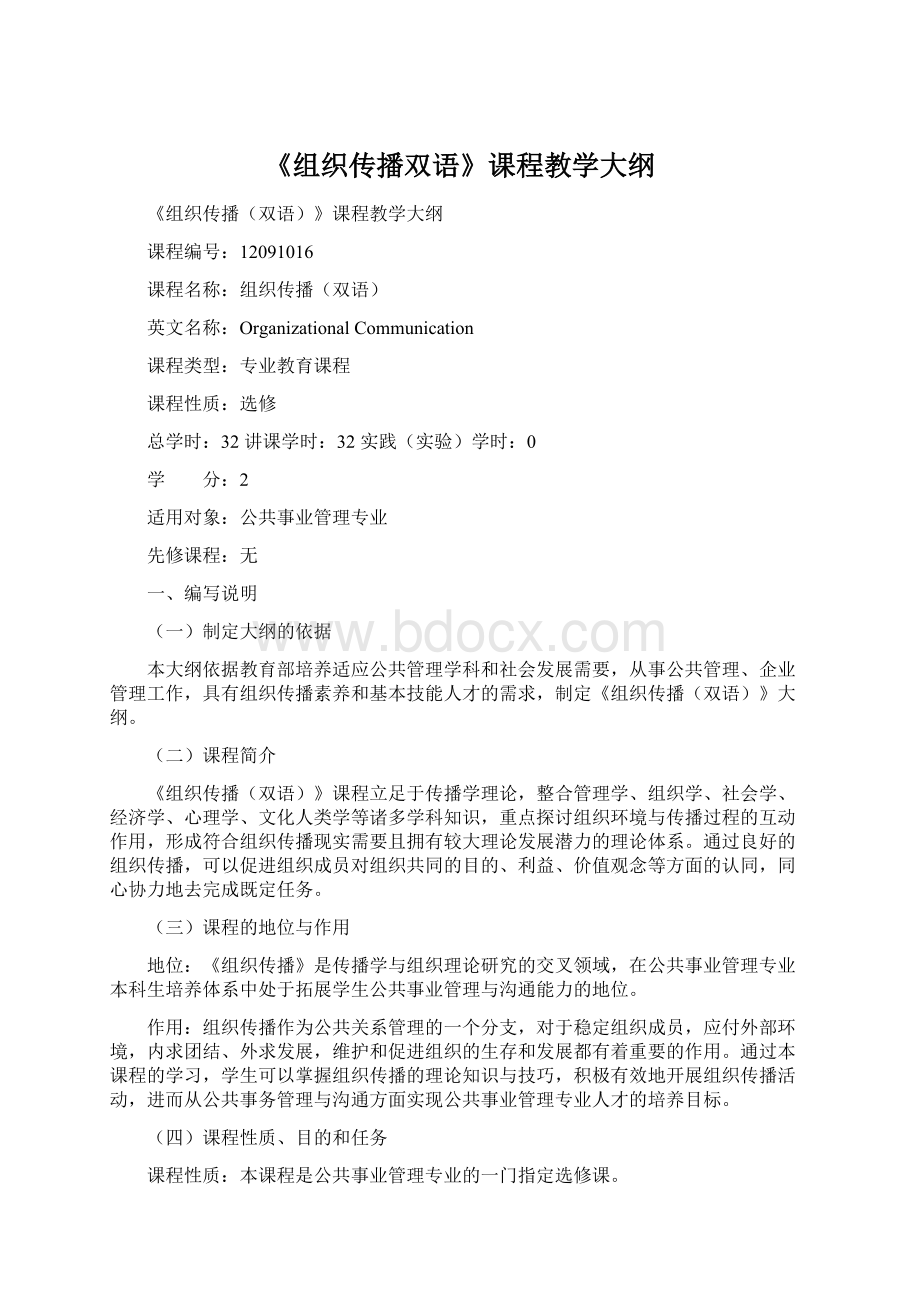《组织传播双语》课程教学大纲Word文档下载推荐.docx
《《组织传播双语》课程教学大纲Word文档下载推荐.docx》由会员分享,可在线阅读,更多相关《《组织传播双语》课程教学大纲Word文档下载推荐.docx(13页珍藏版)》请在冰豆网上搜索。

2
适用对象:
公共事业管理专业
先修课程:
无
一、编写说明
(一)制定大纲的依据
本大纲依据教育部培养适应公共管理学科和社会发展需要,从事公共管理、企业管理工作,具有组织传播素养和基本技能人才的需求,制定《组织传播(双语)》大纲。
(二)课程简介
《组织传播(双语)》课程立足于传播学理论,整合管理学、组织学、社会学、经济学、心理学、文化人类学等诸多学科知识,重点探讨组织环境与传播过程的互动作用,形成符合组织传播现实需要且拥有较大理论发展潜力的理论体系。
通过良好的组织传播,可以促进组织成员对组织共同的目的、利益、价值观念等方面的认同,同心协力地去完成既定任务。
(三)课程的地位与作用
地位:
《组织传播》是传播学与组织理论研究的交叉领域,在公共事业管理专业本科生培养体系中处于拓展学生公共事业管理与沟通能力的地位。
作用:
组织传播作为公共关系管理的一个分支,对于稳定组织成员,应付外部环境,内求团结、外求发展,维护和促进组织的生存和发展都有着重要的作用。
通过本课程的学习,学生可以掌握组织传播的理论知识与技巧,积极有效地开展组织传播活动,进而从公共事务管理与沟通方面实现公共事业管理专业人才的培养目标。
(四)课程性质、目的和任务
本课程是公共事业管理专业的一门指定选修课。
目的:
重点介绍汉语和英语语境下组织传播理论的研究成果,并运用国际化视角考察当前国际上组织传播领域的最新发展状况,帮助学生在组织传播领域确立国际化研究视角和素养,提升他们的组织传播与沟通能力。
任务:
通过对英语语境下组织传播文献的学习,培养学生的国际化思维和视野,使他们学习国外组织传播专业英语的同时,能够把握、追踪、反思国内外组织传播发展的最新成果,对该领域形成具有一定分析和鉴别能力的理性认知。
(五)与其他课程的联系
本课程是管理学、传播学、心理学、组织理论等多学科杂糅发展的结果,是对公共管理学、公共关系、传播学等学科知识的延伸,有助于开阔学生的专业视野、夯实理论基础,延展学生的知识脉络、综合提升学生的专业素养。
(六)对先修课的要求
本课程对先修课没有严格要求,但如具备管理学、公共管理基础知识不仅可以起到巩固已学知识的目的,还有助于本课程的理解与掌握。
二、大纲内容
Chapter1IntroductiontoOrganizationalCommunication
(一)教学目的和任务
通过本章的学习,使学生了解组织传播的基础知识,如组织、传播、组织传播的含义,了解组织传播这一术语及学科产生、发展的演进历程,为后续组织传播理论的学习奠定基础。
(二)教学基本要求
1.Mastertheconceptionofwhatismeantbytheterm“organization”,andthreecommoncomponentsofthevariousdefinitionsoftheterm,aswellasgraspingwhatismeantbytheterm“communication”,basicelementsofcommunicationandhowitappliestotheorganizationalcontextandtheterm“organizationalcommunication”asitisusedwithinthiscourse.
2.Understandtheelementsoforganizationalstructure.Familiarwiththreedifferentwaystheterm“organizationalcommunication”canbeunderstoodaccordingtoStanleyDeetz.
3.Knowdifferencesamongthefourtypesoforganizations:
mutualbenefit,businessconcerns,service,andcommonweal.Andknowsomeofthemajorhistoricaleventsinthecreationofthefieldof“organizationalcommunication.”
(三)教学重点和难点
教学重点:
1.ElementsoforganizationalStructures.
2.Typesoforganizations.
3.Definitionof“communication”and“organizationalcommunication”asitisusedwithinthiscourse.
4.Elementsofcommunicationprocess.
教学难点:
1.Howtodifferentiatemutualbenefitassociations,ServiceOrganizationsandCommonwealOrganizations?
2.Explainwhatismeantbythesocial-scientificapproach,interpretiveapproachandcriticalapproachtoorganizationalcommunication.
(四)教学建议与说明
本章内容是该门课程的第一章,主要是概要性介绍组织传播的基本概念和理论,因而,课程讲授过程中以多媒体课件为基础,注重该学科基本概念逻辑联系的讲解,为该门课程的学习打下坚实的理论基础。
(五)教学内容
1.1
WhatisanOrganization?
1.1.1DefinitionsofOrganization(掌握——知识)
1.1.2OrganizationalStructures(理解——能力)
1.1.3OrganizationalGoals(了解——素养)
1.1.4OrganizationalPeople(了解——素养)
1.2WhatisCommunication?
1.2.1DefiningCommunication(掌握——知识)
1.2.2ElementsofCommunication(掌握——知识)
1.3HistoryofOrganizationalCommunication
1.3.1WaysofViewingOrganizationalCommunication(理解——能力)
1.3.2AConceptualDefinitionof“OrganizationalCommunication”(掌握——知识)
1.3.3AHistoryofOrganizationalCommunication(了解——素养)
1.4ApproachestoOrganizationalCommunicationResearch(了解——素养)
Chapter2ModelsandContextsofCommunication
通过本章传播学基础知识的介绍,使学生具备一定的传播学基础,熟悉传播学的研究模型和分析维度,从而为把传播学知识引入组织领域,进行后续组织传播研究奠定学科和理论基础。
1.Masterthebasicmodelsofcommunication,theconceptionofwhatismeantbytheterm“organization”,andthreecommoncomponentsofthevariousdefinitionsoftheterm.
2.Understandingthefeaturesofthesemodelsandelementsoforganizationalstructure.
3.Befamiliarwiththecriticismtomodelsofcommunicationandhowimprovementcanbemadefromdifferentperspectives.Knowdifferencesamongthefourtypesoforganizations:
mutualbenefit,businessconcerns,service,andcommonweal.
1.Thecontentofthreemodelsofcommunication.
2.Howthesemodelsdevelopedfrommakingupothermodel’sshortcomingsonebyone.
3.Theconceptionoffivecontextsofcommunication.
4.Howthesecontextsarecategorized.
1.Howtodifferentiatethreecommunicationalmodelsinrealsocialsituations.
2.Thefeaturesofeachcontextofcommunication.
本次课主要介绍传播学研究经常应用的三个理论模型和五种情境,因而教师在授课过程中会结合多媒体课件对传播理论模型和情境进行演示,加深学生的认识和理解。
2.1ModelsofUnderstanding:
CommunicationasAction,Interaction,andTransaction
2.1.1WhatisTheValueofCommunication?
(了解——素养)
2.1.2ModelsofUnderstanding:
CommunicationasAction,Interaction,andTransaction(掌握——知识、能力)
2.2ContextsofCommunication(掌握——知识、能力)
2.2.1IntrapersonalCommunication
2.2.2Interpersonalcommunication
2.2.3SmallGroupCommunication
2.2.4OrganizationalCommunication
2.2.5MassCommunication
Chapter3CommunicationBetweenandAmongInternalStakeholders
--FormalCommunicationNetworks
通过本章的学习,使学生初步了解组织传播的正式结构,熟悉利益相关者在组织中传播的路径、类型、存在问题及解决方法,提高学生组织传播中的能力和水平。
1.ExplainWeber’s(1930)beliefsondownwardcommunication.UnderstandKatzandKahn’s(1966)typologyofdownwardcommunication.ClarifyHirokawa’s(1979)twoproblemsassociatedwithdownwardcommunication.
2.BeabletoexplainHirokawa’s(1979)fourfunctionsofupwardcommunication.UnderstandKatzandKahn’s(1966)typologyofupwardcommunication.Explaintheimportanceofemployeesilenceandorganizationaldissent.ExplainFayol’s(1916/1949)perspectiveonhorizontal/lateralcommunication.
3.UnderstandHirokawa’s(1979)fourfunctionsofhorizontal/lateralcommunication.AnalyzeCharlesandMarschan-Piekkari’s(2002)fiveorganizationalbehaviorstoincreasethequalityandquantityofhorizontal/lateralcommunicationinmultinationalcorporations.
4.KnowthehistoryofDownwardCommunication.
1.Thecontent,typesandfunctionsofdownward,upward,andhorizontalcommunication.
2.Howtoimproveeverytypeofcommunicationnetwork.
1.Howtofindacluetounderstandtheinnerframeworkofeachtypeofcommunicationnetwork.
本章本着理论与实践相结合的立场,着重从理论上考察组织传播内在结构的同时,关注组织传播结构中可能出现的各种问题,需要借鉴更多案例进行讲解,使枯燥的理论内容与组织管理实际相结合,让学生能够在丰富的组织实践中掌握组织传播技巧。
3.1DownwardCommunication
3.1.1Whatisdownwardcommunication?
3.1.2TypesofDownwardCommunication(掌握——知识)
3.1.3HistoryofDownwardCommunication(了解——素养)
3.1.4ProblemswithDownwardCommunication(理解——能力)
3.1.5EffectiveMethodsforDownwardCommunication(理解——能力)
3.2UpwardCommunication
3.2.1TypesofUpwardCommunication(掌握——知识)
3.2.2ProblemswithUpwardCommunication(理解——能力)
3.2.3EffectiveMethodsforUpwardCommunication(理解-——能力)
3.3Horizontal/LateralCommunication
3.3.1FunctionsofHorizontal/LateralCommunication(掌握——知识)
3.3.2ProblemswithHorizontal/LateralCommunication(理解——能力)
3.3.3EffectiveMethodsforHorizontal/LateralCommunication(理解——能力)
Chapter4CommunicationBetweenandAmongInternalStakeholders
--InformalCommunicationNetworks
通过本章的学习,使学生了解组织传播中的非正式组织结构及其发挥作用的原理,初步具备使用非正式组织传播网络传递信息和评判信息传播渠道优劣的能力。
1.UnderstandMishra’s(1990)eightreasonsfortheexistenceofgrapevinesinorganizations.DifferentiateamongDavis’s(1969)fourinformalcommunicationnetworks.
2.Explaintherelationshipbetweensocialcapitalandcommunicationnetworks.
3.UnderstandBrass’s(1995)typologyforthemeasurementofties.UnderstandBrass’s(1995)typologyforthemeasuresassignedtoindividualactors.UnderstandBrass’s(1995)typologyforthemeasuresassignedtonetworks.
1.Theconceptionofinformalcommunication
2.Typesofinformalcommunication
1.Howtomeasuretheinformalcommunication
非正式组织传播网络是组织传播渠道的组成部分,虽然在组织传播过程中发挥重要作用,但是由于其往往不具备组织的正式地位、一般有意见领袖主导、传播的信息也良莠不齐而被忽视,因此,本章通过大量案例分析和讨论方法的运用,提高学生对非正式传播网络的认识,增强学生的传播能力。
4.1ConceptionandReasonsofInformalCommunicationNetworks(了解——素养)
4.1.1WhatisInformalCommunicationNetworks?
4.1.2ReasonsofInformalCommunicationNetworks
4.2TypesofInformalCommunicationNetworks(掌握——基本分类知识)
4.2.1ASingleStrandNetwork
4.2.2AGossipNetwork
4.2.3AProbabilityCommunicationNetwork
4.2.4AClusterNetwork
4.3AnalyzingCommunicationNetworks(理解——测量方法、能力)
4.3.1MeasureofTies
4.3.2MeasuresAssignedtoIndividualActors
Chapter5LeaderandFollowerBehaviorsandPerspectives
通过本章的学习,了解管理与领导作为企业管理方式的区别和联系,掌握实现组织领导的主要途径和方法,通过组织传播技巧的强化,增强学生对组织领导的理解和认识。
1.Understandthemeaningofmanagement,leadership,andfollowership.
2.MasterdifferencesbetweenmanagementandleadershipfromToor(2011).Explainthetraitapproachtoleadership.DifferentiatebetweenFredFiedler’sContingencyTheoryandPaulHerseyandKennethBlanchard’sSituationalLeadershipTheoryassituationalapproachestoleadership.
3.UnderstandthesimilaritiesanddifferencesbetweenChesterBarnard’sFunctionsoftheExecutiveandKennethBenneandPaulSheats’ClassificationofFunctionalRolesinGroupsasfunctionalapproachestoleadershipandJamesMacGregorBurns’TransformationalApproachtoleadership.
4.ExplainIraChaleff’sstylesoffollowershipandJamesMacGregorBurns’TransformationalApproachtoleadership.DescribeRogerAdair’s4-DFollowershipModel.
1.Toor’s(2011)fourdifferencesbetweenmanagementandleadership.
2.FredFiedler’s(1967)ContingencyTheoryofLeaderEffectiveness.
3.Threedistinctaspectsoftheirleadershipstyle.
4.ChesterBarnard’s(1938)TheFunctionsoftheExecutive.
5.Trait,situational,functional,relation,andtransformationalapproachestoleadership.
6.IraChaleff’sstylesoffollowership.
7.RogerAdair’s4-DFollowershipModel.
8.McCroskeyandRichmond’sthreeOrganizationalOrientations.
1.Howtousetheapproachestorealizethechangefrommanagementtoleadership.
2.Howtobuildasoundfollowership.
本章内容是对前几章传播技巧的应用,重点通过传播能力